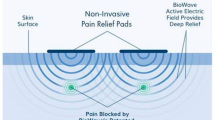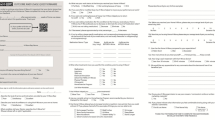Abstract
In a previous study, the H-Wave small-muscle fiber stimulator significantly reduced chronic pain and restored physical function among patients with pain in the lower and upper extremities and spine. In this extended population observational study, a cross-sectional, computer-administered 10-item survey was administered to 6774 patients (3367 men [49.7%], 3406 women [50.3%], and 1 sex not reported [<1%]; mean±SD age, 45.28±10.08 y; range, 18–65 y) with chronic soft-tissue injury or neuropathic pain to assess their therapeutic response. The mean±SE duration of self-administered H-Wave treatment before the survey was completed was 87.35±1.39 d. Sixty-five percent of study participants reported a reduced or eliminated need for pain medication; 79% reported improved functional capacity or activity; and 78% reported 25% or greater reduction of pain. This cross-sectional evaluation represents the largest outcome study on the benefits of the H-Wave device in patients with chronic soft-tissue injury or neuropathic pain. The results suggest that this nonpharmacologic approach may provide an important alternative to standard pharmacologic treatment.
Similar content being viewed by others
References
Gureje O, Von Korff M, Simon GE, Gater R. Persistent pain and well-being: a World Health Organization study in primary care.JAMA. 1998; 280: 147–151.
ACOEM Occupational Medicine Practice Guidelines, second edition. Beverly Farms, Mass: OEM Press;2004:115.
Blum K, Chen TJ, Ross BD. Innate properties of H-Wave device, a small fiber stimulator provides the basis for a paradigm shift of electro-therapeutic treatment of pain with increased functional restoration associated with human neuropathies by affecting tissue circulation.Med Hypotheses. 2005; 64: 1066–1067.
Blum K, Chen TJH, Ross BD. Innate properties of H-wave device, a small fiber stimulator provides the basis for a paradigm shift of electro-therapeutic treatment of pain with increased functional restoration associated with human neuropathies.Townsend Letters. 2005;Jan:101–104
Kumar D, Marshall HJ. Diabetes peripheral neuropathy: amelioration of pain with transcutaneous electrostimulation.Diabetes Care. 1997; 20: 1702–1705.
Kumar D, Alvaro MS, Julka IS, Marshall HJ. Diabetic peripheral neuropathy: effectiveness of electrotherapy and amitriptyline for symptomatic relief.Diabetes Care. 1998; 21: 1322–1325.
Julka IS, Alvaro M, Kumar D. Beneficial effects of electrical stimulation on neuropathic symptoms in diabetes patients.J Foot Ankle Surg. 1998; 37: 191–194.
Tsang BK, Tajkaushi K, Eichhorn JH. Electrical stimulation reduces symptoms of thermal hypersensitivity from injury of sciatic partial ligation in rats.Anesth Analg. 1998; 86: S1-S551.
Blum K, DiNubile NA, Teklen T, et al. H-Wave, a nonpharmacologic alternative for the treatment of patients with chronic soft tissue inflammation and neuropathic pain: a preliminary statistical outcome study.Adv Ther. 2006; 23: 446–455.
Kanji GK.100 Statistical Tests. Thousand Oaks, Calif: Sage Publications, Inc.; 1997.
Xu K, Lichterman D, Kipsky RH, et al. Association of specific haplotypes of D2 dopamine receptor gene with vulnerability to heroin dependence in distinct populations.Arch Gen Psychiatry. 2004; 61: 567–606.
Blum K, Noble EP, Sheridan PJ, et al. Allelic association of human dopamine D2 receptor gene in alcoholism.JAMA. 1990; 263: 2055–2060.
Davison SN, Jhangri GS, Johnson JA. Cross sectional validity of a modified Edmonton symptom assessment system in dialysis patients. A simple assessment of symptom burden.Kidney Int. 2006; 69: 1621–1625.
Breecher HK. The powerful placebo.JAMA. 1955; 159: 1602–1606.
Deyo RA, Walsh NE, Schoenfield LS, Ramamurthy S. A controlled trial of transcutaneous electrical nerve stimulation (TENS) and exercise for chronic back pain.N Engl J Med. 1990; 322: 1627–1634.
Turner J, Deyo RA, Loesser J, Von Koriff M, Fordyce W. The importance of placebo effects in pain treatment and research.JAMA. 1994; 271: 1609–1614.
Wager TD. Expectations and anxiety as mediators of placebo effects in pain.Pain. 2005; 115: 225–226.
Fregni F, Boggio PS, Lima MC, et al. A sham-controlled, phase II trial of transcranial direct current stimulation for the treatment of central pain in traumatic spinal cord injury.Pain. 2006; 122: 11–13.
Solomon S, Elkind A, Freitag F, et al. Safety and effectiveness of cranial electrotherapy in the treatment of tension headache.Headache. 1989; 29: 445–450.
Long DM, Uematsu S, Kouba RB. Placebo responses to medical device therapy for pain.Stereotact Funct Neurosurg. 1989; 53: 149–156.
Author information
Authors and Affiliations
Rights and permissions
About this article
Cite this article
Blum, K., Chen, T.J.H., Pons, M.M. et al. The H-Wave® small muscle fiber stimulator, a nonpharmacologic alternative for the treatment of chronic soft-tissue injury and neuropathic pain: an extended population observational study. Adv Therapy 23, 739–749 (2006). https://doi.org/10.1007/BF02850314
Issue Date:
DOI: https://doi.org/10.1007/BF02850314




